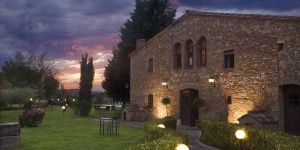
Clots of Sant Julia (clot is a catalan word for "pit, hollow") is probably the most enigmatic rocks formation in the Costa Brava. It is located in a forest between the medieval villages of Vulpellac and Peratallada, inside the Ampurdan. These huge pits and walls where once used to extract stones to build other megaliths in the area (like Sant Sebastià de la Guarda or Ullastret). The most relevant rock is called the "Tro de la Reina" ("Queen Throne"), an ancient hypogeum with a hole in it from stone extraction, and which has the inscription of a cross in a inner wall.
Clots de Sant Julià Map
- Megaliths(1)
How to arrive to Clots de Sant Julià?
How to arrive from:Clots de Sant Julià Photos
Other interesting places near here
-
 1.9 miles away
1.9 miles awayPeratallada Arches are in the village center and they are the paradigm of medieval architecture, in this peaceful location of the Ampurdan. Under the arches can be clearly seen the Catalan tiles and the limestone it was made.
... -
 2 miles away
2 miles awayThe Church of Sant Esteve de Peratallada is outside historic walls of center village, at the end of a lovely tree-lined promenade. It has its origins in the late twelfth century, with additions in later centuries, as the side chapels in the sixteenth and seventeenth centuries. The sober interior, made of stone, contains the tomb of the feudal lord of Gilabert Cruïlles, who died in 1348.
... -
 2.6 miles away
2.6 miles awayTerracotte Museum of Ceramics in la Bisbal d'Emporda village is located in an old factory which operated from the beginning of the twentieth century until 1984. This building, magnificent specimen of industrial architecture, houses the largest collection of ceramic in Catalonia, among an environment that also retains former facilities as large furnaces, fireplaces, etc. The permanent exhibition is divided into different areas in which are exposed ceramic objects involved in the daily life: food tools, decoration, etc. A must for pottery lovers. This museum is opened especially in the......

